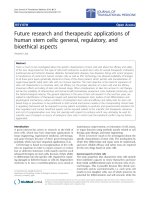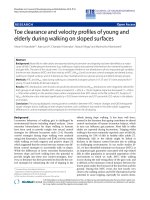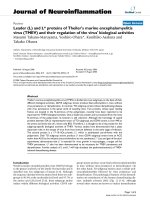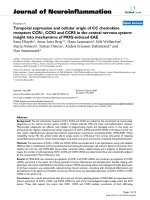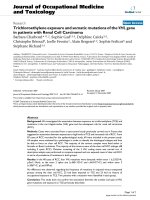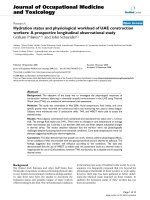Báo cáo hóa học: " Size-dependent catalytic and melting properties of platinum-palladium nanoparticles" doc
Bạn đang xem bản rút gọn của tài liệu. Xem và tải ngay bản đầy đủ của tài liệu tại đây (1.35 MB, 5 trang )
NANO EXPRESS Open Access
Size-dependent catalytic and melting properties
of platinum-palladium nanoparticles
Grégory Guisbiers
1*
, Gulmira Abudukelimu
2
and Djamila Hourlier
3
Abstract
While nanocatalysis is a very active field, there have been very few studies in the size/shape-dependent catalytic
properties of transition metals from a thermodynamical ap proach. Transition metal nanoparticles are very attractive
due their high surface to volume ratio and their high surface energy. In particular, in this paper we focus on the
Pt-Pd catalyst which is an important system in catalysis. The melting temperature, melting enthalpy, and catalytic
activation energy were found to decrease with size. The face centered cubic crystal structure of platinum and
palladium has been considered in the model. The shape stability has been discussed. The phase diagram of
different polyhedral shapes has been plotted and the surface segregation has been considered. The model predicts
a nanoparticle core rich in Pt surrounded by a layer enriched in Pd. The Pd segregation at the surface strongly
modifies the catalytic activation energy compared to the non-segregated nanoparticle. The predictions were
compared with the available experimental data in the literature.
PACS: 65.80-g; 82.60.Qr; 64.75.Jk
Introduction
Bimetallic nanoparticles exhibit unusual physicochemical
properties different from those of the bulk material or
their individual constituents [1,2]. They are very used in
catalysis, fuel cells, and hydrogen storage. These unusual
properties are determined by their size, shape, and com-
position. When considering metallic catalysts, platinum
is a standard material but this material is most expen-
sive than gold [3]. Therefore, to reduce the amount of
platinum and then the cost of the application, one possi-
ble way is to use an alloy of platinum with another
metal. In the present study, the chosen alloy is the bin-
ary Pt-Pd system [4] that we propose to theoretically
study from a thermodynamic approach [5,6], as well as
its pure components. It has been shown previously [5,6]
that thermodynamics may provide useful insights in
nanotechnology where the size of the considered nano-
particles is highe r than approximately 4 nm. Within this
approach, the size and shape effects on the melting tem-
perature, melting enthalpy, phase diagram, and catalytic
activation energy of this system are investigated.
As face-centered cubic (fcc) metals, Pt and Pd can
exhibit a variety of geometrical shapes. Therefore, to
address the shape effect on the materials properties of
these metals at the nanoscale [7,8], the following shapes
have been considered: sphere, tetrahedron, cube, octahe-
dron, decahedron, dodecahedron, truncated octahedron,
cuboctahedron, and icosahedron.
Size-dependent melting properties of Pt and Pd
At the nanoscale, the melting temperature T
m
and melt-
ing enthalpy ΔH
m
, for free-standing nanostructures can
be expressed as function of their bulk corresponding
property, the size of the structure and one shape para-
meter [9].
T
m
T
m,∞
=1− α
shape
D
,
(1)
H
m
H
m,∞
= T
m
T
m,∞
,
(2)
where the shape parameter, a
shape
,isdefinedasa
shape
= AD(g
s
-g
l
)/(VΔH
m, ∞
); D being the size of the structure
(i.e. for a sphere, D is the diameter), A (meter squared)
and V (cubic meter) are the surface area and volume of
the nanostructure, respectively. ΔH
m,∞
is the bulk melt-
ing enthalpy (Joule per cubic meter), whereas g
l
and g
s
arethesurfaceenergyintheliquidandsolidphases
* Correspondence:
1
Institute of Mechanics, Materials and Civil Engineering, Catholic University of
Louvain, 2 Place Sainte Barbe, 1348 Louvain-La-Neuve, Belgium
Full list of author information is available at the end of the article
Guisbiers et al. Nanoscale Research Letters 2011, 6:396
/>© 2011 Guisbiers et al; licensee Springer. This is an Open Access article distributed under the terms of the Creative Commons
Attribution License ( which perm its unrestricted use, distribution, and reproduction in
any medium, provided the original work is properly cited.
(Joule per square meter), respectively. g
l
and g
s
are con-
sidered size independent. This is justified by the fact
that the size effect on the surface energies is less than
4% for sizes higher than 4 nm [10,11]. Indeed, below
this size, edges, and corners of the structures begin to
play a significant role in the surface energy [12].
The size-dependent melting temperatures of platinu m
and palladium are plotted in Figures 1 and 2 respec-
tively. The materials properties of the considered mate-
rials are indicated in Table 1. The melting properties for
the sphere have been calculated using for the solid sur-
face energy the mean value of experimental data [13].
For the other polyh edra shapes, we have considered the
fcc crystal structure of the metals and the respective
solid surface energy for each face [14]. Table s 2 and 3
indicate the parameters used for the calculation of the
melting properties. Experimentally, the melting of
agglomerated Pt nanocrystals (tetrahedrons and cubes)
with an average size around approximately 8 nm starts
at approximately 900 K [15] in relative good agreement
with our theoretical predictions. Molecular dynamics
simulations [16] have calculated the si ze effect on the
melting temperature of Pd and found a
sphere
=0.95nm
while our theory predicts 1.68 nm.
Discussion
At the nanoscale, the shape which exhibits the highest
melting temperature is the one which minimizes the
most the Gibbs’ free energy (G = H-TS); and is th en
the favored one. From Figures 1 and 2, the four most-
stable sha pes among the ones considered are the dode-
cahedron, truncated octahedron, icosahedron, and the
cuboctahedron. Experimentally, truncated octahedron
and cuboctahedron are observed for platinum nanopar-
ticles [8] whereas icosahedron, decahedron, truncated
octahedron and cuboctahedron are observed for palla-
dium nanoparticles [8]. Therefore, our predictions are in
relative good agreement with the observations for palla-
dium and platinum except that dodecahedron and icosa-
hedron are not o bserved for platinum. Other theoretical
calculations confirmed that the dodecahedron is a stable
shape for palladium [17]. More generally, according to
Yacaman et al. [8], the most often observed shapes at
the n anoscale are the cuboctahedron, icosahedron, and
the decahedron.
Furthermore, care has to be taken when we compare
theoretical results with experimental ones due those
materials properties depend on the synthesis process
[18,19]. And then predicted properties from thermody-
namics may differ from the experimentally observed if
the synthesis process is not running under thermodyna-
mical equilibrium. Moreover, thermal f luctuations are
often observed in nanoparticles [20] meaning that the
shape stability is much more complicated than just a
minimisation of the A/V ratio with faces exhi biting the
lowest surface energy.
Nano-phase diagram of Pt-Pd
According to the Hume-Rothery ’s rules, platinum and
palladium forms an ideal solution [21]. In this case, con-
sidering no surface segregation, the liquidus and solidus
Figure 1 Size-dependent melting temperature of platinum
versus the size for different shapes.
Figure 2 Size-dependent melting temperature of palladium
versus the size for different shapes.
Table 1 Materials properties of platinum and palladium.
Materials properties Platinum Palladium
T
m,∞
(K) [40] 2,041.5 1,828
ΔH
m,∞
(kJ/mol) [40] 22 17
ΔH
sub, ∞
(kJ/mol) [41] 565 377
g
l
(J/m
2
)[40] 1.866 1.470
g
s
(J/m
2
) [13] 2.482 2.027
Guisbiers et al. Nanoscale Research Letters 2011, 6:396
/>Page 2 of 5
curves of bulk and nanostructures are calculated from
the following equations [22-24]:
⎧
⎪
⎪
⎪
⎨
⎪
⎪
⎪
⎩
kT ln
x
solidus
x
liquidus
= H
A
m
1 −
T
T
A
m
kT ln
1 − x
solidus
1 − x
liquidus
= H
B
m
1 −
T
T
B
m
,
(3)
where x
solidus
(x
liquidus
) is the composition in the solid
(liquid) phase at a given T, respectively.
T
i
m
is the size-
dependent melting temperature of the element i.
H
i
m
is
the size-dependent melting enthalpy of the element i.
The phase diagram of the Pt-Pd alloy is plotted in Figure
3. We note that the lens shape of the phase diagram is
conserved at the nanoscale; however, the lens width
incr eases for the shapes characterized by a small melting
enthalpy and melting temperature, i.e., exhibiting a strong
shape effect. Moreover, the melting temperature increases
with the concentration of Pt in agreement with Ref. [25].
In order to predict nanomaterials properties more
accurately, we are considering a possible surface segre-
gation which is known as the surface enrichment of one
component of a binary alloy . At the nanoscale, surfa ce
segregation leads to a new atomic species repartition
between the core and the surface. According to Wil-
liams and Nason [26], the surface composition of the
liquid and solid phase are given by:
⎧
⎪
⎪
⎪
⎪
⎨
⎪
⎪
⎪
⎪
⎩
x
surface
solidus
=
x
solidus
1 − x
solidus
e
−(H
sub
z
1v
)
/
(z
1
k
T)
1+
x
solidus
1 − x
solidus
e
−(H
sub
z
1v
)
/
(z
1
kT)
x
surface
liquidus
=
x
liquidus
1 − x
liquidus
e
−
(
H
vap
z
1v
)
(z
1
kT)
1+
x
liquidus
1 − x
liquidus
e
−
(
H
vap
z
1v
)
(z
1
kT)
,
(4)
where z
1
is the first nearest neighbor atoms; z
1ν
is the
number of first nearest atoms above the same plane
(vertical direction). In the case of face-centered cubic
(fcc) crystal structure of Pt and Pd materials, we have z
1
= 12, z
1ν
= 4 for (100) faces an d three for (111) faces.
ΔH
vap
is the difference between the bulk vapori zation
enthalpies of the two pure elements,
H
vap
= H
A
v
,
∞
− H
B
v
,∞
. ΔH
sub
is the difference
between the bulk sublimation enthalpies of the two pure
elements,
H
sub
= H
A
s
,
∞
− H
B
s
,∞
. Element A is chosen
to be the one with the highest sublimation and vaporiza-
tion enthalpies. If the two components are identical,
ΔH
sub
=0andΔH
vap
=0,thereisnosegregationand
we retrieve Equation 3. x
solidus
and x
liquidus
are obtained
from solving Equation 3. Assuming an ideal solution,
only the first surface layer will be different from the
core composition.
Considering the surface segregation in the Pt-Pd sys-
tem, we c an see in Figure 4 that the lens shape of the
surface liquidus/solidus curves is deformed compared to
the core. At a given temperature, the liquidus and soli-
dus curves of the surface are enriched in Pd compared
to the core; meaning that the surface is depleted of Pt
(the higher bond energy element) which is in agreement
with experimental obs ervations[27-29] and other theore-
tical calculations[29-31]. This is due to the fact that Pd
has a lower solid surface energy, a lower cohesive energy
compared to Pt and also because diffusion is enha nced
at the nanoscale [32].
Size-dependent catalytic activation energy of Pt-Pd
The catalytic activation e nergy is the energy quantity
that must be overcome in order for a chemical reaction
to occur in presence of a catalyst. The low the catalytic
Table 2 Solid surface energies for platinum and
palladium materials [13].
Faces Platinum Palladium
g
s
(111) (J/m
2
) 2.299 1.920
g
s
(100) (J/m
2
) 2.734 2.326
g
s
(110) (J/m
2
) 2.819 2.225
Table 3 Number of (hkl) faces for each shape.
Shape Number of
(111) faces
Number of
(100) faces
Number of
(110) faces
Tetrahedron 4 0 0
Cube 0 6 0
Octahedron 8 0 0
Decahedron 10 0 0
Dodecahedron 12 0 0
Truncated
octahedron
860
Cuboctahedron 8 6 0
Icosahedron 20 0 0
Figure 3 Phase diagram of the Pt-Pd system for different
shapes. Different shapes at a size equal to 4 nm and at the bulk
scale. The solid lines indicate the liquidus curves whereas the
dashed lines indicate the solidus ones.
Guisbiers et al. Nanoscale Research Letters 2011, 6:396
/>Page 3 of 5
activation energy is, the most active the catalyst is. It is
thus an important kinetic parameter linked to the che-
mical activity. Indeed, the catalytic activation energy is a
linear function of the work function [33-35]. For pure
materials, the catalytic activity depends on the fraction
of surfa ce atoms on corners and edges while for binary
compounds it depends also on the surface segregation.
Recently, it has been showed by Lu and Meng in Ref.
[36] that the size-dependent catalytic activation energy,
E
ca
could be obtained from the following relation:
E
ca
E
ca,∞
= T
m
T
m,
∞
(5)
Therefore, it means that the size-dependent catalytic
activation energy decreases with size.
To compare with experimental results, the ratio of the
catalytic activation energies between tetrahedral (D =
4.8 nm) an d spherical (D =4.9nm)pureplatinum
nanoparticles has been determined around 0.66 in excel-
lent agreement w ith the experimentalvalueof0.62±
0.06 announced by Narayanan and El-Sayed [37-39].
Moreover, the ratio of the catalytic activation energies
between cubic (D = 7.1 nm) and spherica l (D = 4.9 nm)
pure platinum nanoparticles is around 1.01 in relat ive
good agreement with the experimental value of 1.17 ±
0.12 [37-39].
From the size-dependent Pt-Pd phase diagram, the
melting temperature of the alloy can be deduced. Equa-
tion 6 describes the melting temperature of the bulk Pt-
Pd while Equations 7 and 8 describe the nanoscaled
melting temperature of a non-segregated and segregated
spherical nanoparticle (with a diameter equal to 4 nm),
respectively.
T
solidus
(
Bulk
)
= 1828 + 236x − 22x
2
,
(6)
T
solidus core
(
D =4nm
)
= 1019 + 258x − 11 x
2
,
(7)
T
solidus surface
(
D =4nm
)
= 1264−111 e x p
−x
0.016
−58 exp
−x
0.0020
−73 exp
−x
0.1043
,
(8)
where x represents the alloy compositi on. For a sphe-
rical Pt-Pd nanoparticle with a diameter equal to 4 nm,
by combining Equations 5-8, E
ca
seems to evolve quad-
ratically with the composition when the segregation is
not considered; which is not the case when the segrega-
tion is considered (Figure 5). For the segregated Pt-Pd
nanoparticle, a maximum in the catalytic activation
energy is reached around 16% of Pt composition.
Conclusions
In conclusion, it has been shown that thermodynamics
can still provide use ful insights in nanoscience and
more specifically in catalysis. The future development of
catalysts and fuel cells is dependent upon our ability to
control the size, shape, and surface chemistry of indivi-
dual nanop articles. Future theoretical work will have to
consider the environment in which the particles are
synthesized as well as the preparation method because
these parameters can have a great influence on the
shape stability and on the catalytic properties.
Acknowledgements
G. Guisbiers would like to thank the Belgian Federal Science Policy Office
(BELSPO) through the “Mandats de retour” action for their financial support.
Author details
1
Institute of Mechanics, Materials and Civil Engineering, Catholic University of
Louvain, 2 Place Sainte Barbe, 1348 Louvain-La-Neuve, Belgium
2
Yili Normal
Figure 4 Phase diagram of the Pt-Pd system considering the
surface segregation effect. Surface segregation effect at a size
equal to 4 nm for a spherical nanoparticle.
Figure 5 Composition dependency of the catalytic activation
energy for a spherical nanoparticle of Pt-Pd. Nanoparticle of Pt-
Pd with a size equal to 4 nm.
Guisbiers et al. Nanoscale Research Letters 2011, 6:396
/>Page 4 of 5
University, 298 Jie Fang Lu Street, Yi Ning Shi, Xinjiang, China
3
Institute of
Electronics, Microelectronics and Nanotechnology, Scientific City, Avenue
Henri Poincaré BP60069, 59652 Villeneuve d’Ascq, France
Authors’ contributions
GG carried out the calculations on the size and shape effects on the melting
temperature, phase diagrams and catalytic activation energy; drafted the
manuscript. GA carried out the calculations on the phase diagrams (shape
effect) in collaboration with GG. DH carried out the calculations on the
phase diagrams (segregation effect) in collaboration with GG. All authors
read and approved the final manuscript.
Competing interests
The authors declare that they have no competing interests.
Received: 11 March 2011 Accepted: 26 May 2011
Published: 26 May 2011
References
1. Maye MM, Kariuki NN, Luo J, Han L, Njoki P, Wang L, Lin Y, Naslund HR,
Zhong CJ: Electrocatalytic reduction of oxygen: gold and gold-platinum
nanoparticle catalysts prepared by two phase protocol. Gold Bulletin
2004, 37:217.
2. Deng L, Hu W, Deng H, Xiao S: Surface segregation and structural
features of bi-metallic Au-Pt nanoparticles. Journal of Physical Chemistry C
2010, 114:11026.
3. Sealy C: The problem with platinum. Materials Today 2008, 11:65-68.
4. Tao F, Grass ME, Zhang Y, Butcher DR, Renzas JR, Liu Z, Chung JY, Mun BS,
Salmeron M, Samorjai GA: Reaction-driven restructuring of Rh-Pd and Pt-
Pd core-shell nanoparticles. Science 2008, 322:932-934.
5. Guisbiers G, Buchaillot L: Universal size/shape-dependent law for
characteristic temperatures. Physics Letters A 2009, 374:305-308.
6. Guisbiers G: Size-dependent materials properties towards a universal
equation. Nanoscale Research Letters 2010, 5:1132-1136.
7. Barnard AS: Using theory and modelling to investigate shape at the
nanoscale. Journal of Materials Chemistry 2006, 16:813-815.
8. Yacaman MJ, Ascencio JA, Liu HB, Gardea-Torresdey J: Structure shape and
stability of nanometric sized particles. Journal of Vacuum Science &
Technology B 2001, 19:1091-1103.
9. Guisbiers G, Buchaillot L: Modeling the melting enthalpy of
nanomaterials. Journal of Physical Chemistry C 2009, 113:3566.
10. Liang LH, Zhao M, Jiang Q: Melting enthalpy depression of nanocrystals
based on surface effect. Journal of Materials Science Letters 2002,
21:1843-1845.
11. Lu HM, Jiang Q: Size-dependent surface energies of nanocrystals. Journal
of Physical Chemistry B 2004, 108:5617-5619.
12. Barnard AS, Zapol P: A model for the phase stability of arbitrary
nanoparticles as a function of size and shape. Journal of Chemical Physics
2004, 121:4276.
13. Vitos L, Ruban AV, Skriver HL, Kollar J: The surface energy of metals.
Surface Science 1998, 411:186-202.
14. Abudukelimu G: Thermodynamical approach of phase diagrams of
nanosystems: size and shape effects. Ph D thesis University of Mons-
Hainaut; 2009.
15. Wang ZL, Petroski JM, Green TC, El-Sayed MA: Shape Transformation and
Surface Melting of Cubic and Tetrahedral Platinum Nanocrystals.
Journal
of Physical Chemistry B 1998, 102:6145-6151.
16. Miao L, Bhethanabotla VR, Joseph B: Melting of Pd clusters and
nanowires: a comparison study using molecular dynamics simulation.
Physical Review B 2005, 72:134109.
17. Montejano-Carrizales JM, Rodriguez-Lopez JL, Pal U, Miki-Yoshida M, José-
Yacaman M: The completion of the platonic atomic polyhedra: The
dodecahedron. Small 2006, 2:351-355.
18. Xiong Y, Xia Y: Shape-controlled synthesis of metal nanostructures: the
case of palladium. Advanced Materials 2007, 19:3385-3391.
19. Cheong S, Watt JD, Tilley RD: Shape control of platinum and palladium
nanoparticles for catalysis. Nanoscale 2010, 2:2045-2053.
20. Vollath D, Fischer FD: Structural fluctuations in nanoparticles. Journal of
Nanoparticle Research 2009, 11:433-439.
21. Kittel C: Introduction to solid state physics. 7 edition. New York: Wiley; 1995.
22. Guisbiers G, Wautelet M, Buchaillot L: Phase diagrams and optical
properties of phosphide, arsenide, and antimonide binary and ternary
III-V nanoalloys. Physical Review B 2009, 79:155426.
23. Guisbiers G, Liu D, Jiang Q, Buchaillot L: Theoretical predictions of wurtzite
III-nitrides nano-materials properties. Physical Chemistry Chemical Physics
2010, 12:7203.
24. Guisbiers G, Abudukelimu G, Wautelet M, Buchaillot L: Size, shape,
composition, and segregation tuning of InGaAs thermo-optical
properties. Journal of Physical Chemistry C 2008, 112:17889-17892.
25. Sankaranarayanan SKRS, Bhethanabotla VR, Joseph B: Molecular dynamics
simulation study of the melting of Pd-Pt nanoclusters. Physical Review B
2005, 71:195415.
26. Williams FL, Nason D: Binary alloy surface compositions from bulk alloy
thermodynamic data. Surface Science 1974, 45:377-408.
27. Renouprez AJ, Rousset JL, Cadrot AM, Soldo Y, Stievano L: Structure and
catalytic activity of palladium-platinum aggregates obtained by laser
vaporisation of bulk alloys. Journal of Alloys and Compounds 2001, 328:50.
28. Rousset JL, Cadrot AM, Cadete Santos Aires FJ, Renouprez A, Mélinon P,
Perez A, Pellarin M, Vialle JL, Broyer M: Study of bimetallic Pd-Pt clusters
in both free and supported phases. Journal of Chemical Physics 1995,
102:8574-8585.
29. Ferrando R, Jellinek J, Johnston RL: Nanoalloys: From Theory to
Applications of Alloy Clusters and Nanoparticles. Chemical Reviews 2008,
108:845-910.
30. Massen C, Mortimer-Jones TV, Johnston RL:
Geometries and segregation
properties of platinum-palladium nanoalloy clusters. Journal of the
Chemical Society, Dalton Transactions 2002, 4375-4388.
31. Luyten J, Creemers C: Surface segregation in ternary Pt-Pd-Rh alloys
studied with Monte Carlo simulations and the modified embedded
atom method. Surface Science 2008, 602:2491-2495.
32. Guisbiers G, Buchaillot L: Size and shape effects on creep and diffusion at
the nanoscale. Nanotechnology 2008, 19:435701.
33. Vayenas CG, Bebelis S, Pliangos C, Brosda S, Tsiplakides D: Electrochemical
activation of catalysis New York: Kluwer Academic; 2001.
34. Kemball C: Catalysis on evaporated metal films. I. The efficiency of
different metals for the reaction between ammonia and deuterium.
Proceedings of the Royal Society of London. Series A, Mathematical and
Physical Sciences 1952, 214:413-426.
35. Vayenas CG, Ladas S, Bebelis S, Yentekakis IV, Neophytides S, Yi J,
Karavasilis C, Pliangos C: Electrochemical promotion in catalysis: non-
faradaic electrochemical modification of catalytic activity. Electrochimica
Acta 1994, 39:1849-1855.
36. Lu HM, Meng XK: Theoretical model to calculate catalytic activation
energies of platinum nanoparticles of different sizes and shapes. Journal
of Physical Chemistry C 2010, 114:1534-1538.
37. Narayanan R, El-Sayed MA: Shape-dependent catalytic activity of platinum
nanoparticles in colloidal solution. Nano Letters 2004, 4:1343.
38. Narayanan R, El-Sayed MA: Catalysis with transition metal nanoparticles in
colloidal solution: nanoparticle shape dependence and stability. Journal
of Physical Chemistry B 2005, 109:12663-12676.
39. Narayanan R, El-Sayed MA: Some aspects of colloidal nanoparticle
stability, catalytic activity, and recycling potential. Topics in Catalysis 2008,
47:15-21.
40. Martienssen W, Warlimont H: Springer Handbook of Condensed Matter and
Materials Data Berlin: Springer; 2005.
41. Arblaster JW: Vapour pressure equations for the platinum group
elements. Platinum Metals Review 2007, 51:130-135.
doi:10.1186/1556-276X-6-396
Cite this article as: Guisbiers et al.: Size-dependent catalytic and melting
properties of platinum-palladium nanoparticles. Nanoscale Research
Letters 2011 6:396.
Guisbiers et al. Nanoscale Research Letters 2011, 6:396
/>Page 5 of 5

